Preface: Back in August my friend and fellow Metblogs contributor, David Markland (also the creator of the excellent Creepy LA website), told me he was aiming to pull some storytellers together for an event to take place around Halloween and wanted to know if I’d be interested in participating. I said absolutely in part because October seems very far away from August, giving me plenty of time to flesh out a spooky tale based on an actual historic horror I’d been longing to tell.
Fast forward to the day of the event — called the Haunted Speakeasy –Â October 25, and there I am bemoaning a lost Sunday spent kicking my procrastinatory self between bits of cranking out a ragged version of the story so that I wouldn’t have to resort to either inexcusably flaking on David altogether or being forced to dust off the likes of past stuff such as the Haunted Griffith Park Picnic Table or the Carnivorous At-Large Tumor.
Basically after about six hours spent frustratingly pounding the keyboard and my forehead, and about an hour before showtime I printed out the piece, gave it a test read to see how far it ran past the five-minute limit David had imposed (Susan clocked it at just shy of 12 minutes, yikes), and then pedaled my ass over to the corner of Prospect and Rodney in Los Feliz where the Haunted Speakeasy was to take place. When my time came, I got up in front of the friendly and receptive crowd apologized for its unedited length and read it… rough draft, run-on sentences, typos and all. Its end was greeted with a nice measure of applause, probably attributable less to how good the story was and more to the deathless thing finally being done.
But I’ll leave that for you to decide if you wish to click to the other side of the jump where you’ll find my half-assed mixing of historical fact and odd fiction complete and untouched (but augmented with a few illustrations and images). Get comfy for I present to you:
Tales From The Archive: Playground Of The Devils!
Long before the tale I’m about to tell transpired, the hilly terrain we now know as the recreational oasis that is Griffith Park and longer still before the lands encompassing it would be named Los Angeles, the rugged expanse of the inland most reaches of the Santa Monica Mountains seem to have been considered an ominous and foreboding place – a zone best left alone.
It has been supposed that as far back as prehistoric times when primitive man shared the coastal plain with real monsters the likes of dire wolves, mammoths, giant sloths, and saber-toothed cats, far more supernatural creatures defended bloody claims to sections of the region’s ranges.
Whether these ancient beings were resident evils real or imagined can only be conjectured, as no records exist to explain man’s lack of presence or failure to exploit its otherwise habitable conditions and abundance of natural resources. There are no stories passed down through the generations. No pteroglyphs or wood carvings depicting unearthly nightmarish beings. Nothing to shed light on such an anomalous absence.
We do know that tribal communities existed only on the area’s outskirts, and that few of our ancestors visited, much less lingered or lived in and among those canyons, perhaps because those that did dare venture in rarely were seen alive again.
Documentation of indigenous aversion to the place is first found in 1769 during the expedition of Gaspar de Portola when Father Juan Crespi described an encounter at a Chumash camp on the east bank of the Los Angeles River near what is now Atwater Village in which the tribe’s chief was adamant in his attempt to dissuade the padre accompanied by a squad of Spanish soldiers sent on orders of Portola himself to cross the river and explore the hills in search of a place to spend the following nights.
 Crespi later wrote of the incident: “After I pointed to the mountains directly across the river, the leader repeatedly shook his head, pounded a fist into his palm, crossed his arms over his chest and covered his face with his hand as his subjects knelt down wailing. It was decided we would not challenge such a stern and ominous warning.â€
Crespi later wrote of the incident: “After I pointed to the mountains directly across the river, the leader repeatedly shook his head, pounded a fist into his palm, crossed his arms over his chest and covered his face with his hand as his subjects knelt down wailing. It was decided we would not challenge such a stern and ominous warning.â€
To disregard it very well might have cost Crespi his life, doomed the expedition and perhaps changed the course of California history.
Instead they camped uneventfully away from the suspicious region, and 12 years later the settlement of El Pueblo de la Reina de Los Angeles took place in 1781. But in the years subsequent a series of disappearances and strange happenings occurred until the area was dubbed Patio de Los Diablos – Playground of the Devils – with many a parent warning their wayward children to avoid the place, or threatening to send them there if they didn’t behave.
Those children grew to warn their own children and the legend thrived well into the next century. As Los Angeles boomed, so did the number of sightings of all manner of strange goings-on and even stranger creatures: covens of flesh-eating witches, ravenous packs of chupacabras or inexplicable balls of lightning – most of which were discounted and dismissed by the authorities.
And so in this background we come, perhaps not a moment to soon, to the historic hate-filled rampage from which was born the most vengeful specter of evil ever said to lord over the darkest crags and deepest canyons of those hills for longer than anyone today has been alive, going as far back as when the park’s namesake Griffith Jenkins Griffith was but a 21-year-old ne’er do well who’d yet begun to amass his vast fortune and holdings.
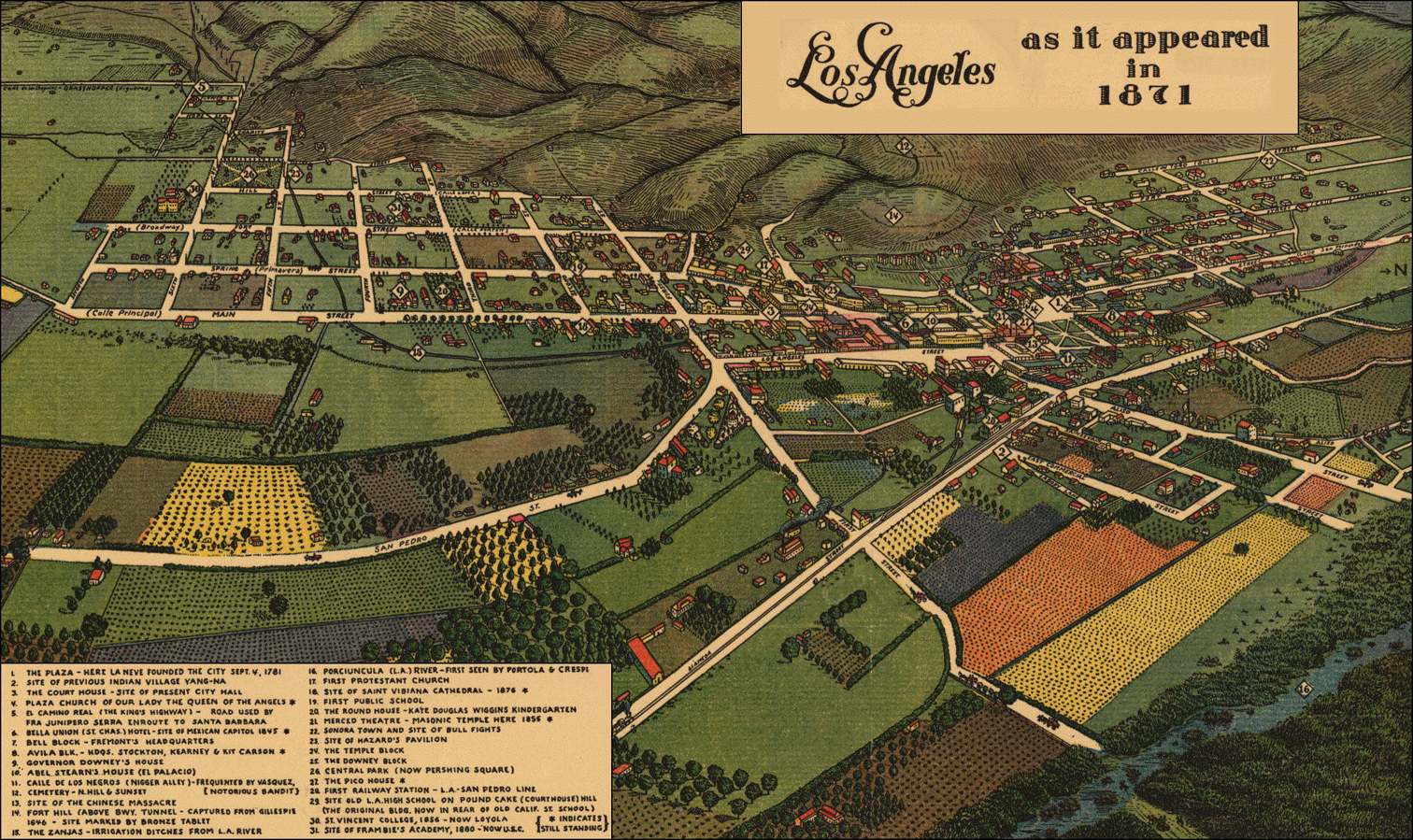 (click for the bigger picture)
(click for the bigger picture)
As timely coincidence would have it yesterday marked the 138th anniversary of one of the darkest episodes in the history of our unfair city. The infamous Chinese Massacre of October 24, 1871 took place in an alleyway of tremendously ill repute then known as Calle de Los Negros in what was then the city’s original Chinatown, but is now known as Los Angeles Street between the plaza where Los Angeles was founded and Arcadia Street to the south.
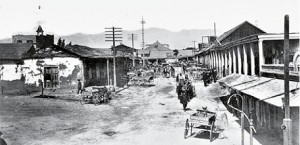 On that fateful day along that filthy 500-foot-long dirt road lined by gambling houses, saloons, dance halls, bordellos, and other assorted dives, two rival Chinese gangs – Nin Yung Company and Hong Chow Company – set the wickedness in motion when they decided to trade bullets to settle a long-standing dispute over the ownership of a young woman. In the course of the gun battle, a police officer named Robert Thompson was accidentally shot and killed. News quickly spread of the tragedy and anger stoked by a prevailing racial animosity led to an enraged mob of anglos and latinos some 500 strong charging into the area, where they attacked residents and left not a single home or shop undamaged.
On that fateful day along that filthy 500-foot-long dirt road lined by gambling houses, saloons, dance halls, bordellos, and other assorted dives, two rival Chinese gangs – Nin Yung Company and Hong Chow Company – set the wickedness in motion when they decided to trade bullets to settle a long-standing dispute over the ownership of a young woman. In the course of the gun battle, a police officer named Robert Thompson was accidentally shot and killed. News quickly spread of the tragedy and anger stoked by a prevailing racial animosity led to an enraged mob of anglos and latinos some 500 strong charging into the area, where they attacked residents and left not a single home or shop undamaged.
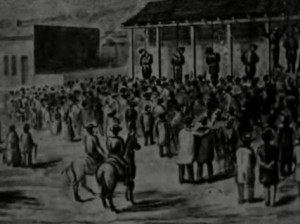 Five hours later a reported 19 innocent Chinese men and boys had been killed, either by gun, knife, blunt force, hanging, or a combination of all four. Regardless of how they died, all victims were strung up, either by their necks or ankles from awnings, wagons and fence posts up and down Calle de Los Negros.
Five hours later a reported 19 innocent Chinese men and boys had been killed, either by gun, knife, blunt force, hanging, or a combination of all four. Regardless of how they died, all victims were strung up, either by their necks or ankles from awnings, wagons and fence posts up and down Calle de Los Negros.
But survivors tell of a 20th victim, equally innocent of the death of the police officer but lost to both the coroner’s tally and to history because he somehow survived an initial and brutal attack. Guilty of nothing more than rightfully attempting to protect his pregnant wife from a band of rampaging thugs who entered his home, 22-year-old Kong Wei Lun, a laborer by day and studiously exceptional magician’s apprentice by night, was abducted, beaten severely, stabbed in the neck, and strung up by his boots from a roof beam, only to be found still alive several hours later in the remaining chaos not by any authorities who might have saved him, but rather by other monsters who put to shame anything believed to be haunting the nearby hills with what can only be described as an insatiable bloodlust.
Cutting Kong down while She Sheng, his unharmed wife, pleaded for mercy, the five vigilantes pushed her aside, tossing him into the back of a horse-drawn wagon and setting out to the north and west from Chinatown until they eventually crossed the dry Los Angeles River bed near where the zoo is today and were observed ascending a trail into the Devils’ Playground. It was the last time any were seen alive.
Nearly an hour later, witnesses as far away as the Crescenta Valley reported the sudden appearance of a huge fireball breaking the stillness of the night and emanating from the area around Mineral Wells Canyon, but when police and firefighters arrived on scene, instead of confronting a wildfire they were faced with the smoldering corpses of the five vigilantes and their horse, surrounding the blackened remains of a long-dead oak tree inside whose hollowed trunk they discovered the unidentifiably cremated remains if a sixth victim. Strangest of all, no other trees or wildlife in the vicinity were burned, even the grass beneath the burned bodies where they fell was unsinged.
Despite the absence of inclement weather or any bomb-making materials, in the official incident report authorities allege that all died in an accidental explosion of some sort, perhaps a lightning strike. But many in Chinatown knew what happened: that Kong had been stuffed into the tree’s trunk and it had been set ablaze. As to the explosion, rumors were whispered of Kong’s knowledge of the dark arts and that somehow he was able to transform himself into a deadly combustible force. No one was more certain of its cause than She Sheng, who told of a dream she had the night after his death, wherein she was visited by her husband who appeared before her surrounded by flame, laying a hand that felt like burning coals upon her pregnant belly and kissing her once before vanishing in a ball of fire whose sensation of heat was so real she woke from a sound sleep thinking her room was burning. A few months later when their son was born with an inexplicable wisps of fiery red hair, she knew that in his death Kong had unleashed a hellbent fury and that the Playground of the Devils now had a powerful new tenant who wasted little time exacting revenge.
There are those who say Kong Wei Lum, otherwise soon known in local lore as the Fire Demon of Mineral Wells had only just begun. Among them the notorious bandit Tiburio Vasquez, a frequenter of the gambling parlors of Calle de Los Negros, who told of spending but one harrowing night night in the local hills eluding lawmen in 1874 before finding much more to his liking the less haunted hiding places among the rocks much further out in Santa Clarita that now bear his name.
Well into the next century and long after the land’s ownership by Griffith Jenkins Griffith who purchased the property 11 years after the massacre in 1882 only to donate it to the city in 1896 after reportedly being gravely frightened by a fiery manifestation, authorities strove to logically and dismissively explain away the cause of pretty much any conflagration occurring within those hills – going to especially great lengths covering up those involving deaths whose evidence apparently pointed to spontaneous combustion.
But at the first signs of smoke or the discovery of another charred body in otherwise unburned brush locals always kept the legend burning bright by blaming the Fire Demon — especially in the wake of seemingly unexplainable events – none more tragic than the burn that remains the deadliest fire in Los Angeles history – and it happened in the very place Kong was killed and his evil spirit said to lurk.
On the afternoon of October 3, 1933, a small fire flared up on a remote slope of Mineral Wells Canyon. Though historians are quick to point out the area was parched from more than four months without rain, the morning had been damp and drizzly, an unexpected break from the hot and dry Santa Ana winds that had been baking the earth and the almost 4,000 men who had been employed by the county making 40 cents an hour clearing brush in the park.
When first spotted the fire seemed hardly more than a nuisance by both workers and foremen what with the seemingly unlimited manpower onhand. But one might argue that such a large number of potential victims – and none trained in firefighting techniques — was too much for a Fire Demon to ignore, certainly not one still filled with such a burning desire for limitless vengeance.
Attacked haphazardly by volunteers armed simply with shovels under inadequate supervision, the fire they’d initially dismissed rejected initial attempts to bring it under control and instead quickly grew to catastrophic proportions in but a matter of minutes. Survivors spoke of the flames as a living predatory thing that seemed to seek men out.
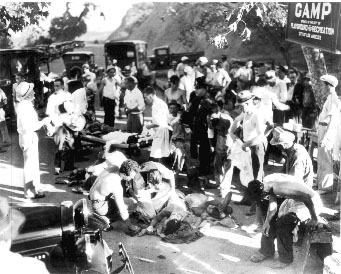 “It turned as if it had seen us and raced up the canyon consuming brush and the bodies of men who moments before had been scrambling downwind and uphill in vain attempts to elude the hellstorm,†said Anton Shaeffer who lived to tell what he saw only because he was able to dive into the refuge of the girl’s club swimming pool just as his hair caught fire.
“It turned as if it had seen us and raced up the canyon consuming brush and the bodies of men who moments before had been scrambling downwind and uphill in vain attempts to elude the hellstorm,†said Anton Shaeffer who lived to tell what he saw only because he was able to dive into the refuge of the girl’s club swimming pool just as his hair caught fire.
Another man, Miguel Holquin, who survived only by jumping into a stone planter he was building around a tree, and covering himself with sand swore he heard a maniacal laughter as the flames rushed over him toward a group of eight men frantically cutting a fire break, killing them all in a manner of seconds.
Upon evacuation of the mass of men to safety the fire mysteriously lost its rampaging fury, and was contained later that evening by a crew of but 50 municipal firefighters.
In the end the official death toll was listed at 29 with 150 injured. But at an investigation afterwards, a group of victims’ dependents told the County Board of Supervisors the total dead was 52. Even worse, the International Labor Defense League claimed a total of 58 fatalities, and its chairman went so far as to accuse the coroner’s office and sheriff’s deputies of burying many of the bodies in the park shortly after the fire was fully contained.
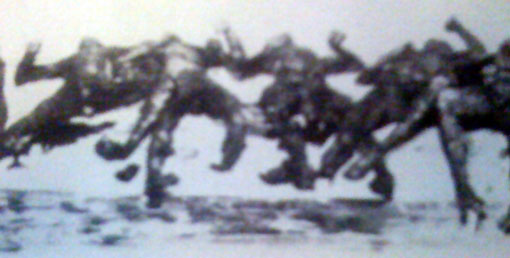 (The recovered remains of some of the fire’s victims)
(The recovered remains of some of the fire’s victims)
In distracting response, the Coroner’s Inquest and local newspapers described the league as a communist organization, which was apparently enough to discredit it and derail any investigation into charges that they unintentionally gave the Fire Demon of Mineral Wells so many new friends to play with by intentionally increasing the population of tormented souls buried out there somewhere in the Playground of the Devils.
 Follow
Follow